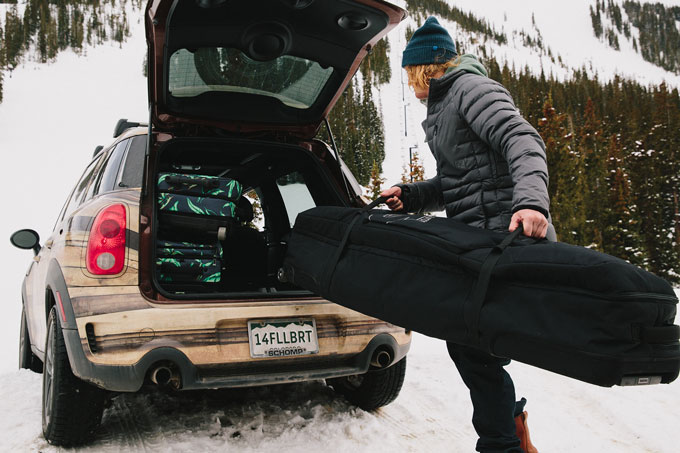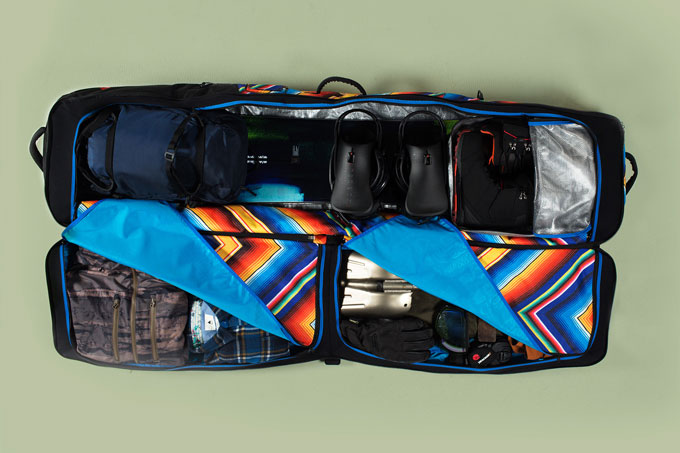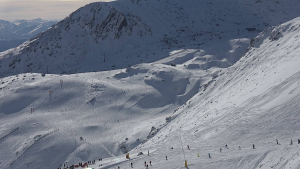Navigating Airline Baggage Restrictions, How to Pack and Pay – Travel

Your bag’s gonna be dragged over mud, dirt and snow, and then right through multiple planes trains and automobiles; best make sure it’s up to the task Image:: Burton Snowboards
Mountainwatch | Chris Booth
Let’s face it, the golden days of air travel are over. Gone are the days when you could wrangle an upgrade with a smooth smile and a nice shirt. These days you’d be hard up talking your way into a few excess kilos in your baggage. Now we live in an age of numbers and margins, and that check-in attendant doesn’t care about how exotic your trip is, or if your gear is for ‘sporting use’. We’ve done the math, and it doesn’t matter which way you slice it, travelling with ski or snowboard gear puts you at or near the baggage allowance limits for long haul overseas travel. And yet, for every skier and boarder keen on experiencing the mystical trees of Japan, the dizzying heights of the European Alps, or bacon-flavoured bourbon in the US, long-haul travel is a necessary evil.
Everyone has war stories. Whether they be lost luggage spoiling trips, overweight baggage charges that cost more than the cost of the flight, or half-marathons towing the skiing equivalent of a dead body between concourses on impossible connections.
To some it’s probably all too hard, and in most overseas destinations you can hire really good stuff. But if you’re going to spend all that cash – and emotional investment – on a trip o/s; we honestly can’t see why you wouldn’t want to take the gear you love, know and cherish.
Thankfully, you can now prepay an extra bag, or an extra few kilograms with most airlines, which is way better than taking your chances at the airport. It’s also more economical in the end than renting overseas. But that only gets you part of the way.
If you are going to lug your gear across the planet you may as well do it properly. Here’s how:
Gear bag
— Make a label and cable-tie it to your bag – if you’ve ever had a bag lost, you will know exactly how important this is. Make it durable – laminate it if you can, use coloured paper. Make it obvious.
– Boards should be stacked on top of each other, on the bottom of the bag, with the bindings removed – placed next to each other on the top board.
– Place your skis flat. Use elastic bands to hold the brakes up. It’s a better use of space and will travel better. If you have two pairs of skis, place one pair flat and the other pair together through the middle. This will create a skeleton that makes it more stable on its wheels.
– Roll your outerwear and place it at the base of the bag. This will fill out the base of the bag. Alternatively you can spread it through the bag if you are extra keen about protecting your equipment.
– Poles go through the middle between the skis.
– Leave everything else out. Otherwise your bag is just too heavy and a pain to lug around.
To find the perfect snowboard bag, you really need to weigh up a few options. Firstly, what length are you looking for? If you’re a girl, and your biggest board doesn’t reach over 150cm there isn’t much point in buying a 180cm monster. But similarly, if you’re packing a few boards, of varying lengths, keep in mind that you’ll need something that is long and large enough to carry it all.

Colour-matched perfection. Does it get better? Check out the hashtag #whatipack on Instagram for more inspiration. Image:: Burton Snowboards
Don’t skimp on bags. The more expensive bags will generally use lighter materials, with more durable construction. The better brands will also include features you weren’t even aware of. Check Burton’s video above, their board bag syncs up with their wheelie bags for even smoother operation.
All major brands do good ski bags these days, but the Douchebag is by far the lightest wheelie ski bag on the market. It is ribbed to increase rigidity, is adjustable to various ski lengths, and low profile so you don’t look like a heavy traveller as you roll up to the check-in counter. You can also get a carry-on style boot bag that ‘piggy backs’ on top of the ski bag, but detaches to become a carry-on wheelie boot bag so it doesn’t count towards that all too precious check-in allowance – see below.
Carry on bags.
Don’t pack your boots into your check-in luggage. Use a carry-on wheelie – it’s more sophisticated than carrying them or strapping them to your backpack and staff can’t tell how heavy it is, plus, you can stuff in all your socks and undies (let’s face it, socks, undies and ski boots are essential). And if you look at the rules, most airlines allow a ‘carry on bag’ and a ‘handbag’ – which loosely translates to a backpack – so effectively you are giving yourself another piece of luggage for nothing. Do it.
Luggage bag
– Pack only the ski gear that you will need to last you four days. Any more and you’re over-packing.
– Roll everything that you pack. It makes better use of space, is quicker, and preserves your clothing better.
– Don’t pack anything else. You’ll wear what you’ve got on. And if you are extra smart, you’ll multifunction ski wear and mid layers that double as casual wear: see Burton, Patagonia, The North Face and Rip Curl for some great examples.
– If you feel the need to pack more, see rule three.
A SNOWBOARD LUGGAGE ROAD TEST, CIRCA 2010:
With air travel you can never be 100% sure how it’s going to play out. But travel, like luck, favours the prepared. Make it easy on yourself and pack intelligently. Then maybe, just maybe, that smooth smile and nice shirt just might work after all.
But promise us one thing; you won’t be one of those people with their knees pressed against the carousel waiting for their big fat bag to arrive.
Airline awards
The difference between travelling to the Americas (Canada, USA and Latin America) and the rest of the world is that it uses a ‘piece’ system, that is, two pieces of about 23kg (46kg). The rest of the world allows 23 kg only. Here we have evaluated the major airlines offering services out of Australia to see who is the most generous when it comes to traveling with baggage.
We ranked the airlines according to how much they allow, how expensive pre-paid extra baggage is, and what their excess baggage penalties (at the airport) are. The results are based on the table below with Emirates coming out as the best airline to fly to Europe (also gets points for the one stop over option at Dubai before flying to various European cities) and Qantas as the first choice for the Americas.
RANKINGS
Americas:
1. Qantas
2. Etihad
3. Virgin
Rest of the World:
1. Emirates
2. Etihad
3. Malaysian
NB: pieces of > 32kg have other charges across all airlines.
The Americas – the piece system
| AIRLINE | ALLOWANCE | COST OF ADDITIONAL BAGS | PENALTIES |
| QANTAS | 2 pieces (maximum 23kg (50lb)) | $84 per piece | $50 per extra piece $40 heavy charge for each piece weighing over 23kg# |
| UNITED | 2 x 23kg | $70 per piece | $200 for oversize (158cm) and/or overweight |
| EMIRATES | 2 bag(s) of 23 kgs each | $US123 per additional piece | $US175 per additional piece |
| MALAYSIAN AIRLINES | 2 pieces at 23 kg (50 lbs) / 269 cm (107 inch) for 2 pieces | N/A | Charged $US25 per piece for the first 2 pieces. |
| SINGAPORE AIRLINES | 2 bags of 23 kg each | N/A | $180 per piece |
| VIRGIN | 2 pieces of 23kg | N/A | 150 per piece |
| ETIHAD | 2 pieces of 23kg | Extra 23kg piece for $137 or 32kg piece for $187. | Increase from 23 to 32kg for $50. |
Rest of the world: the weight system
| AIRLINE | ALLOWANCE | COST OF ADDITIONAL BAGS | PENALTIES |
| QANTAS | 1 piece (maximum 23kg (50lb) per piece) | $210 / 5kg over | $120 per extra piece. $50 heavy charge for each piece weighing over 23kg |
| EMIRATES | 30kg (no bag spec) | From $210 for 5kg to $1050 for 25kg – 30% Discount Online | $60/kg |
| MALAYSIAN AIRLINES | 30 kg (66 lbs) / Not exceeding 158 cm (62 inch) | $MYR90 per 5kg | N/A |
| SINGAPORE AIRLINES | 20kg | N/A | $60/kg |
| VIRGIN | C/S Etihad 32kg C/S Singapore 20kg C/S Virgin Atlantic 23kg |
N/A | $30/kg for Asia $70/kg for Europe |
| JETSTAR | NONE | With purchase: 15kg – 40kg.
After purchase: $160 for a piece (only 15kg need to add more after) |
$25/kg over purchased allowance |
| ETIHAD | 30kg | $50-$70/kg |




